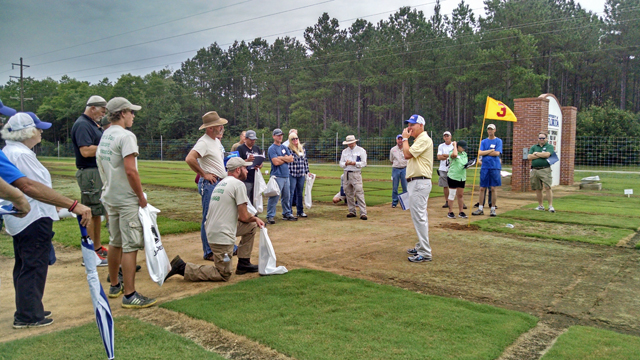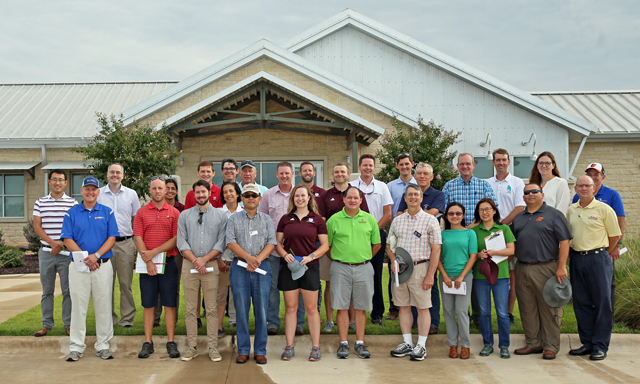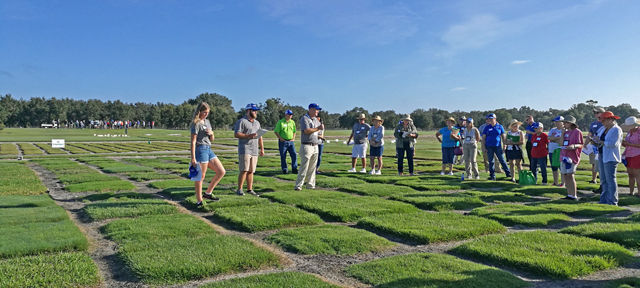
Teamwork is proving that the grass can be green on both sides of the fence, even in the absence of water! Dr. Kevin Kenworthy, Professor, University of Florida, discusses the SCRI Turf Breeding Project, at the Gulf Coast Turfgrass Expo and Field Day – Jay, FL
Bryan Unruh, UF/IFAS Turfgrass Specialist, WFREC
Urban landscapes, golf courses, and sports venues provide many functional, recreational, and aesthetic benefits. Key functional benefits of turfgrass include soil erosion control, carbon sequestration, ground water recharge, and heat dissipation in our cities, that are becoming increasingly covered with concrete and asphalt. Recreational activities on natural turfgrass lead to improved health as children and adults participate in community sports, or spend time maintaining their landscapes. Similarly, a well-kept and properly managed landscape is pleasing to the eye, increases property values, and leads to community pride and ownership. The value of turfgrass to the economy is well documented. Landscape maintenance expenditures and tourism contribute significantly to Florida’s economy.
However, as population grows and water availability for irrigating turfgrass becomes more limited, the resulting policies on water restrictions, and public opinion impact turfgrass production, and the performance of installed turf, posing challenges to the turfgrass industry. To address these concerns, some policy makers have even considered eliminating turf from new construction. However, the ecosystem trade-offs of removing turf are not well understood, and may create more serious consequences.
To address turfgrass water use related issues, a 24-member team of turfgrass breeders, extension specialists, plant physiologists, irrigation engineers, molecular biologists, and agricultural socio-economists from five major universities across the southern U.S. in Florida, Georgia, North Carolina, Oklahoma, and Texas are collaborating together to learn more about turfgrass water use, and to develop grasses that require less irrigation. Funding for this effort stems from the team receiving two United States Department of Agriculture (USDA), National Institute of Food and Agriculture (NIFA), Specialty Crop Research Initiative (SCRI) grants totaling over $8 million. In the initial project, conducted from 2010-2015, the team exchanged and evaluated nearly 2,000 experimental germplasm accessions, and identified 140 advanced lines for short-term drought stress – 40 each of bermudagrass, zoysiagrass and St. Augustinegrass, and 20 seashore paspalum. Additionally, the majority of these lines were screened for salinity responses, since poor water quality (i.e., salinity) will be an increasing problem in the future.

SCRI Turf Breeding Team at their semi-annual planning meeting held this past summer in College Station, TX.
In 2015, a second project was funded that will allow further evaluation of the 140 advance lines identified in the first project. These grasses will be further vetted under differing drought/irrigation scenarios of long-term drought common to Texas and Oklahoma, versus short-term drought common to Florida, Georgia, and North Carolina. Additionally, shade and salinity assessments will be conducted along with identifying production practices that may limit the acceptance of these improved grasses in the marketplace. The team is also studying socio-economic measures to determine factors that influence producer pricing and consumer demand for improved turfgrasses. Finally, a comprehensive Extension outreach plan is in place to educate, promote and inform end-users of the environmental and economic impacts of newly developed cultivars. Additionally, demonstration landscapes are being installed in each state through partnering extension specialists and agents with industries and government agencies.

Dr. Kevin Kenworthy speaks to the attendees about the SCRI Turf Breeding project at the North Central Florida Turfgrass Field Day in Citra, FL.
Cultivars released from this team effort and include: ‘TamStar’ St. Augustinegrass, ‘TifTuf’ Bermudagrass, ‘Tahoma 31’ Bermudagrass, ‘CitraBlue’ St. Augustinegrass, with several forthcoming zoysiagrasses.
The synergistic approach of this project will avoid duplication of research efforts and capitalize the genetic diversity for developing environmentally sustainable turfgrasses with wider geographical adaptation and broader regional impacts. This CAPs project will significantly increase the productivity, sustainability, and the economic gain of both the individual state turfgrass programs, and the overall turfgrass industry.
For additional information, visit the SCRI Turf Breeding Effort website,or follow the team on Twitter @SCRITURF.
- Southern Scientists are Collaborating to Develop Drought Resistant Turfgrasses - September 7, 2018
- Florida Sod Production BMP Manual is Being Revised - January 26, 2018
